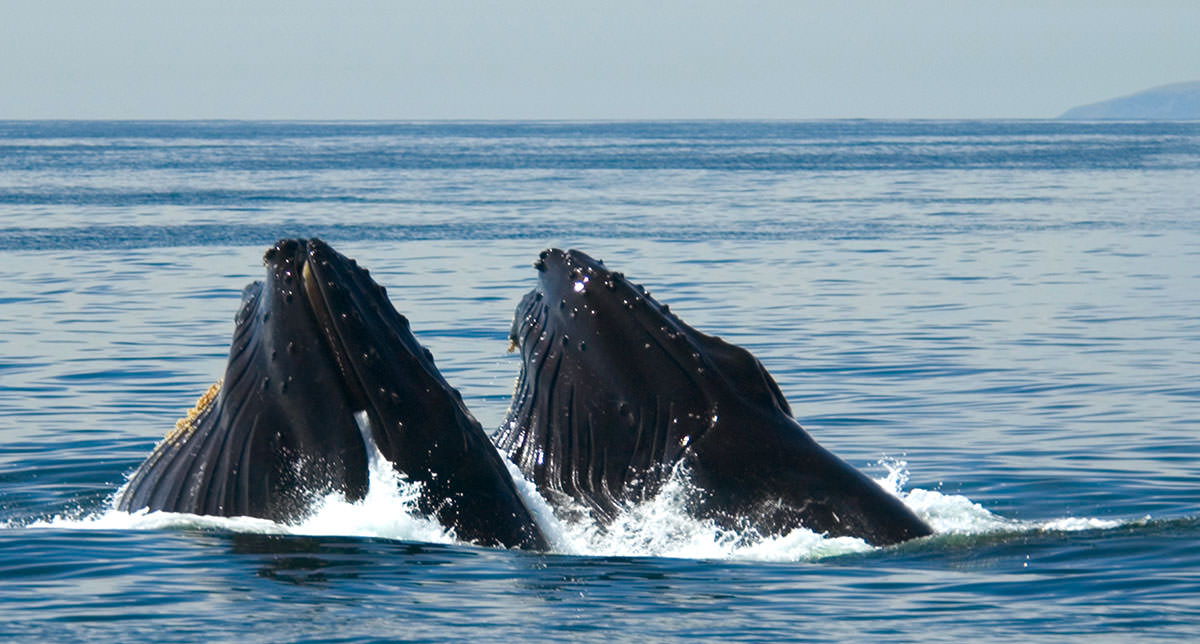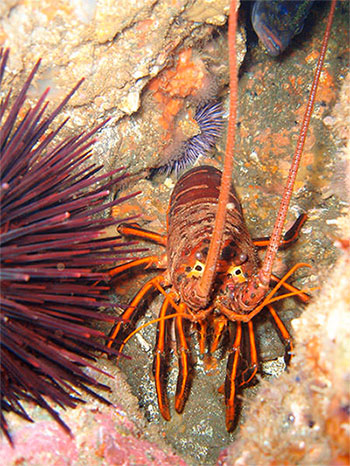Wildlife Health
Channel Islands

Why is it a concern?
For "key" species in marine sanctuaries (e.g., keystone species, foundation species, indicator species, and other focal species) measures of condition and health can be important in determining the likelihood that these species will persist or recover and continue to provide vital ecosystem functions and services. Measures of health (condition) may include growth rates, fecundity, recruitment, age-specific survival, tissue contaminant levels, pathologies (disease incidence, tumors, deformities), injuries and the presence and abundance of critical symbionts or parasite loads.
There are several key species (such as spiny lobster, sea urchins, and sea otters), whose health is closely tied to the health and abundance of kelp beds which provide habitat within the sanctuary. When predators, such as spiny lobster, are removed, sea urchins can reproduce in greater numbers and consume more kelp.
The health of seabird populations is also tracked closely because many seabird species serve as good indicators of ecosystem health. While some species, such as Brown Pelican and Brandts Cormorant are increasing and improving; other species (Cassins Auklet, Xantuss Murrelets, Ashy Storm-Petrel, Tufted Puffin, Rhinoceros Auklet, and Common Murre) are declining or not breeding due to impacts from changing ocean conditions, predation on eggs, young, and adults, and pollutants.
There is also a strong interest in continuing to research and monitor whale populations within the Channel Islands. Fin whales, humpback whales, blue whales, and gray whales are found within the sanctuary. Emerging threats to large whales are ship strikes and declines in available krill that could also be affecting blue whales, and possibly other species.
Overview of Research
Research conducted by Sanctuary scientists and partners provides critical information to address existing and emerging resource conservation and management issues. The Overview of Research highlights some, but not necessarily all, of the research activities completed or ongoing at the Sanctuary.
| Project Name | PI and contacts | Links |
|---|---|---|
|
Small Scale Spatial Variation in Population Dynamics and Fisherman Response in a Coastal Marine Fishery |
UCSB, Jono Wilson |
http://www.plosone.org/article/ |
|
Channel Islands Biogeographic Assessment |
NOAA; National Centers for Coastal Ocean Science |
|
|
Whale Sightings Database/ Channel Islands Naturalist Corp |
CINMS, Shauna Bingham; Channel Islands National Park, David Begun |
|
|
Lobster Commercial Fisheries Research Partnership |
California Sea Grant, UCSB; Carrie Culver |
http://www.csgc.ucsd.edu/NEWSROOM/ |
|
Kelp Forest Monitoring |
Channel Island National Park, David Kushner |
http://science.nature.nps.gov/im/ |
|
Seabird Nesting Habitat Restoration |
Channel Island National Park |
|
|
PISCO Monitoring and Surveys |
UCSB, Jenn Caselle; UCSC, Mark Carr |
|
|
Whole Body Environmental Contaminants in Fish |
UCSB, Milton Love |
|
|
Tracking and behavioral monitoring of cetaceans near CINMS shipping lanes |
Cascaidia Research, John Calambokidis |
|
|
Spatial and Temporal Occurrence of Blue Whales off the U.S. West Coast, with Implications for Management |
Marine Mammal Institute, Oregon State University, Bruce Mate; National Marine Fisheries Service, UC Santa Cruz, and University of Maryland |
|
|
Port Access Route Study |
US Coast Guard |
http://www.environmentaldefensecenter.org/learn/ |

Science Needs and Questions
- What is the abundance, distribution, and status of populations of seabirds, marine mammals, and other endangered or sensitive species in the Sanctuary?
- Are there predictive relationships that relate monitored water conditions to whale distribution on a scale that can mitigate whale ship interactions?
- How does the acoustic environment affect whale behavior and ecology?
Education and Outreach Material
Responsibly Watching Californias Marine Wildlife
Protecting your Channel Islands Brochure
Protecting Blue Whales and Blue Skies Forum overview
References
Adams, J. 2008. Cassins Auklet (Ptychoramphus aleuticus) pp. 204-212. In: W.D. Shuford and T. Gardali (eds.). California bird species of special concern: a ranked assessment of species, subspecies, and distinct populations of birds of immediate conservation concern in California. Studies of Western Birds 1. Western Field Ornithologists, Camarillo, California, and California Department of Fish and Game, Sacramento, California.
Barlow, J. and K. Forney. 2007. Abundance and population density of cetaceans in the California current system. Fishery Bulletin 105:509-526.
Blasius, M. and G. Goodmanlowe. 2008. Contaminants still high in top level carnivores in the Southern California Bight: levels of DDT and PCBs in resident and transient pinnipeds. Marine Pollution Bulletin 56(12):1973-1982.
Burkett, E.E., N.A. Rojek, A.E. Henry, M.J. Fluharty, L. Comrack, P.R. Kelly, A.C. Mahaney, K.M. Fien. 2003. Report to the California Fish and Game Commission: status review of Xantuss Murrelet (Synthliboramphus hypoleucus) in California. Unpublished report, California Depart-ment of Fish and Game, Habitat Conservation Planning Branch, Status Report 2003-01, Sacramento, California. 70pp (plus appendices).
Calambokidis, J. and J. Barlow. 2004. Abundance of blue and humpback whales in the eastern North Pacific estimated by capture-recapture and line-transect methods. Marine Mammal Science 20(1):63-85.
Calambokidis, J., J. Barlow, E.A. Falcone, L. Schlender, A.B. Douglas, G.H. Steiger, K.B. Ford. 2005. Changes in abundance of humpback whales off the west coast of the U.S. Abstract (Proceedings) 16th Biennial Conference on the Biology of Marine Mammals, San Diego, CA, December 12-16, 2005.
Calambokidis, J., A. Douglas, E. Falcone, and L. Schlender. 2007. Abundance of blue whales off the US West Coast using photographic identification. Conducted Report for PO: AB133F06SE3906 from Southwest Fisheries Science Center, La Jolla, CA. Electronic document available from: www.cascadiaresearch.org
Calambokidis, J., E.A. Falcone, T.J. Quinn, A.M. Burdin, P. Clapham, J.K.B. Ford, C.M. Gabriele, R. LeDuc, D. Mattila, L. Rojas-Bracho, J. M. Straley, B.L. Taylor, J. Urbán, D. Weller, B.H. Witteveen, M. Yamaguchi, A. Bendlin, D. Camacho, K. Flynn, A. Havron, J. Huggins, N. Maloney. 2008. SPLASH: Structure of Populations, Levels of Abundance and Status of Humpback Whales in the North Pacific, Final report for Contract AB133F-03-RP-00078. Electronic document available from: http://www.cascadiaresearch.org/SPLASH/splash.htm
Capitolo. P.J., J.N. Davis, L.A. Henkel, W.B. Tyler, and H.R. Carter. 2008. Aerial photographic surveys of breeding colonies of Brandts, Double-Crested, and Pelagic Cormorants in Southern California, 2005-2007. Unpublished report, University of California, Institute of Marine Sciences, Santa Cruz, California. 49pp.
Carter, H.R., G.J. McChesney, D.L. Jaques, C.S. Strong, M.W. Parker, J.E. Takekawa, D.I. Jory, D.L. Whitworth. 1992. Breeding populations of seabirds in California, 1989-1991. Volume I - Population estimates. Unpublished report, U.S. Fish and Wildlife Service, Northern Prairie Wildlife Research Center Dixon, California. 491pp.
Carter, H.R., G.J. McChesney, J.E. Takekawa, L.K. Ochikubo, D.L. Whitworth, T.W. Keeney, W.R. McIver, C.S. Strong. 1996. Population monitoring of seabirds in California: 1993-1995 aerial photographic surveys of breeding colonies of Common Murres, Brandts Cormorants and Double-crested Cormorants. Unpublished final report, U.S. Geological Survey, California Science Center, Dixon, California.
Carter, H.R., W.R. McIver, J. Adams, J.Y. Takekawa. 2007. Population monitoring of Ashy Storm-Petrels and Cassins Auklets at Santa Cruz Island, California, in 2006. Unpublished report, Carter Biological Consulting, Victoria, British Columbia; U.S. Fish and Wildlife Service, Ven-tura, California; and U.S. Geological Survey, Moss Landing & Vallejo, California. 32pp.
Carter, H.R., W.R. McIver, G.J. McChesney. 2008. Ashy Storm-Petrel (Oceanodroma homochroa). pp. 117-124. In: W.D. Shuford, and T. Gardali (eds.). California Bird Species of Special Concern: A ranked assessment of species, subspecies, and distinct populations of birds of immediate conservation concern in California. Studies of Western Birds 1. Western Field Ornithologists, Camarillo, California, and California Department of Fish and Game, Sacramento, California.
CDFG (California Department of Fish and Game), Partnership for Interdisciplinary Studies of Coastal Oceans, Channel Islands National Ma-rine Sanctuary, and Channel Islands National Park. 2008. Channel Islands Marine Protected Areas: First 5 Years of Monitoring: 2003-2008.
Engle, D.L. 2006. Assessment of coast water resources and watershed conditions at Channel Islands National Park, California. Technical Report NPS/NRWRD/NRTR-2006/354.Jarvis et al. 2007
Gress, F. 1995. Organochlorines, eggshell thinning, and productivity relationships in Brown Pelicans breeding in the Southern California Bight. Ph.D. dissertation, University of California Davis, California.
Karnovsky, N.J., Spear, L.B., Carter, H.R., Ainley, D.G., Amey, K.D., Ballance, L.T., Briggs, K.T., Ford, R.G., Hunt, G.L., Jr., Keiper, C., Mason, J.W., Morgan, K.H., Pitman, R.L. and Tynan, C.T. 2005. At-sea distribution, abundance and habitat affinities of Xantuss Murrelets. Marine Ornithology 33:89-104.
Lafferty, K.D. 2004. Fishing for lobsters indirectly increases epidemics in sea urchins. Ecological Applications 14:6 1566-1573.
Lafferty K.D. and M.D. Behrens, 2005. Temporal variation in the state of rocky reefs: does fishing increase the vulnerability of kelp forests to disturbance? Proceedings of the Sixth California Islands Symposium. 2005. D.K. Garcelon and C.A. Schwemm (Eds.). National Park Service Technical Publication CHIS-05-01, Institute for Wildlife Studies, Arcata, CA. 499-508pp.
Leet, W.S., C.M. Dewees, R. Klingbeil, E.J. Larson. 2001. Californias living marine resources: a status report, California Department of Fish and Game.University of California. Agriculture and Natural Resources. Publication SG01-11.
Sydeman W.J., M.M. Hester, J.A. Thayer, F. Gress, P. Martin, J. Buffa. 2001. Climate change, reproductive performance and diet composition of marine birds in the Southern California Current system, 1969-1997. Progress in Oceanography 49:309-329.
Whitworth, D.L., J.S. Koepke, H.R. Carter, F. Gress, D. Lipski. 2006. Nest monitoring of Xantuss Murrelets at Anacapa Island, California: 2006 annual report. Unpublished report, California Institute of Environmental Studies, Davis, California (prepared for the American Trader Trustee Council and Channel Islands National Park). 27pp.

